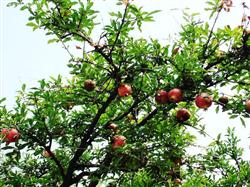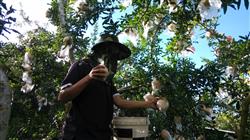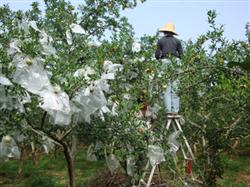Pomegranate tree planting: what are the reasons why pomegranates don't bear fruit?

What are the reasons why pomegranates don't bear fruit? Please help us to introduce that pomegranate trees generally do not bear fruit, the main factors may be light, fertilization, flower degradation or branches are too dense; the following is a detailed introduction and solutions (for reference). The causes of pomegranate trees do not bear fruit; first, caused by lack of light: pomegranate is a light-loving plant, during its vegetative growth and flowering, lack of light or overcast and rainy weather will cause pomegranate trees not to bear fruit. Lack of light will cause the vegetative growth of the plant to be relatively prosperous, which is not conducive to the accumulation of nutrients in the body, thus affecting the reproductive growth, so it will fall off immediately after flowering; if it encounters continuous overcast and rainy weather during flowering, the pistil will not be fertilized normally, causing it to blossom but not bear fruit. Second, unreasonable fertilization: pomegranate florescence is very sensitive to water and nitrogen fertilizer, many people think that pomegranate flowering needs a lot of water and nutrients, so a large number of fertilizers and watering, resulting in pomegranate vegetative growth is too exuberant, resulting in a large number of flowers and fruits. Third, the degeneration of pomegranate floral organ: floral organ development and fruit growth are controlled by nutritional status to a great extent. Due to the lack of nutrition, the flower organs of fruit trees are dysplastic, forming degenerated flowers and deformed flowers, which fall off after flowering. Fourth, pomegranate branches are too dense to cause: pomegranate grows fast and can draw branches twice a year. Dense branches and erect strong branches not only affect ventilation and light transmission, but also compete with flowers and fruits, affect fruit setting and reduce quality, and make pomegranates suffer from diseases and insect pests. Pomegranate solution: first, pomegranate throughout the growing season to ensure that there is sufficient light, as long as there is no lack of water, pomegranate is not afraid of strong light. Method 2. Strengthen the management of fertilizer and water, give priority to phosphorus and potassium during the growth period, and do not apply too much nitrogen fertilizer to avoid the influence of excessive growth of branches and leaves on flowering and fruit setting. In addition, it was dormant after applying enough organic fertilizer before the leaves fell in late autumn to promote its germination in the spring of the following year and branch quickly and sturdily. It is best to use loose, breathable and fertile sandy loam. Method 3. According to the characteristics of long flowering period and low fruit setting rate of pomegranate trees, we should actively do a good job of flower and fruit protection. Foliar fertilizer was sprayed before flowering, young fruit stage and fruit expansion stage respectively, combined with melon and fruit Zhuangtieling to promote pomegranate tree self-regulating nutrition matching, strong pedicel, flower protection and fruit protection. Method 4. Erase the excess sprouts as early as possible, and leave 50 cm of ungrown branches with space to be excised and twisted to a flat oblique state; when the backbone branches are upright, the method of brace and pull should be adopted to open the backbone branches at a certain angle. to maintain the balance between vegetative growth and reproductive growth. And take comprehensive and effective technical measures, such as ring cutting, to make it more results and faster results. After cutting, Qihuawang No. 2 was smeared in time to transform the growth function of fruit trees into reproductive function, activate and strengthen floral genes and floral ovaries, breed a large number of high-quality flower buds and promote differentiation, blossom and fruit more, and produce high quality steadily year after year. Click to get more pomegranate tree planting techniques click to get more fruit planting techniques
- Prev

Who taught me the pomegranate bagging technique?
Who taught me the pomegranate bagging technique? And what are the benefits of pomegranate bags? Pomegranate bagging can improve quality, increase output, prevent diseases and insect pests, improve the rate of fine fruit, reduce mechanical damage in the process of picking and transportation, and make the fruit surface clean. Pomegranate bag.
- Next

Pomegranate tree planting: what should be paid attention to during pomegranate coloring period?
Now the pomegranate begins to enter the coloring period, what should we pay attention to in the pomegranate coloring period? Please introduce the pomegranate from late August to early September, the pomegranate begins to enter the coloring period; the pomegranate coloring period should be managed to avoid uneven coloring, fruit cracking and insect pests; management methods can be referred to below. ...
Related
- Moge, come on! The staff of the peasant association in the producing area of cantaloupe were frightened when the crowd gathered.
- Causes and Solutions of low Fruit setting rate of Apple
- Symptoms and control measures of passion fruit virus disease
- Fruit growing lesson: how do apple orchards keep high yields?
- Can you build orchards in the mountains? What are the pros and cons?
- How to manage the coloring period of Crisson grape?
- This paper introduces the processing technology of two kinds of fig products.
- How much is a month for retired teachers in rural areas by 2020?
- How can strawberry planting increase sugar content? We should pay attention to management in many aspects.
- What are the cultivation techniques on how to improve the yield of golden fruit?

